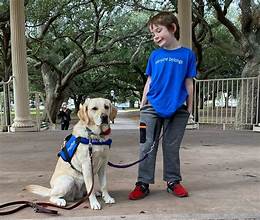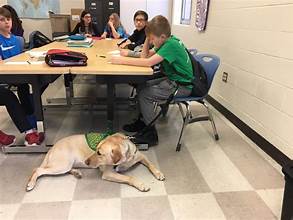How Animals Help Children Thrive
For many children with ADHD, autism, anxiety, or other mental disabilities, service and therapy animals provide critical support. In school, these animals can help with focus, emotional regulation, and social interaction, making learning more accessible and reducing stress.
Parents often find themselves in a maze of uncertainty when considering how to incorporate a service or therapy animal into their child’s IEP or 504 Plan. This guide is designed to provide a clear path, offering step-by-step explanations that will bring relief and reassurance.
Understanding the Difference: Service vs. Therapy Animals
- Service Animals: Trained to perform specific tasks for a child with a disability (e.g., alerting to anxiety, providing sensory input, or preventing elopement) and legally protected under the Americans with Disabilities Act (ADA).
- Therapy animals offer comfort and emotional support, but they may not be trained to perform specific tasks. Often included under 504 Plan accommodations to improve emotional well-being and classroom access.

Tip: Always clarify whether the animal is a service animal or a therapy animal in your school request.
Step 1: Get Documentation
Schools will require documentation from a qualified professional stating that the animal is necessary for the child to access education.
Include:
- Diagnosis of the child’s disability
- How the animal helps with learning, focus, or emotional regulation
- Any safety considerations or training certifications
Step 2: Request Inclusion in IEP or 504 Plan

- IEP: Include the animal under “related services” if it supports learning, emotional regulation, or safety.
- 504 Plan: Include the animal as an accommodation to ensure equal access to education.
- Submit a written request to the school with supporting documentation.
Sample phrasing:
“My child’s service dog assists with focus, anxiety management, and transitions. I request that the dog be allowed in the classroom and during school activities as part of their 504 Plan accommodations.”
Step 3: Collaborate With the School
- Discuss where the animal will be allowed, how breaks will be managed, and any other relevant classroom logistics.
- Address all safety and hygiene concerns upfront.
- Ensure that all staff members interacting with the child are aware of the animal’s role and guidelines.
Step 4: Review and Monitor
- Once approved, regularly check that accommodations are being followed.
- Document any challenges or successes, which can help during plan reviews.
- Adjust the plan if the child’s needs change or if new strategies emerge.
Benefits of Service and Therapy Animals in School
- Improved focus and attention for children with ADHD
- Emotional regulation for anxiety, sensory processing, or autism
- Social engagement and improved peer interactions
- Reduced stress and school avoidance
Real-life Example: A child with ADHD uses a small service dog to provide deep-pressure input when feeling overwhelmed, helping them stay on task during reading and math lessons.
Final Thoughts
Incorporating a service or therapy animal into a child’s school plan is more than just having a pet — it’s a powerful tool for inclusion, emotional support, and academic success. When parents successfully navigate this process, they can feel a deep sense of accomplishment and pride in their ability to advocate for their child.
By understanding their rights, providing proper documentation, and collaborating with educators, parents can ensure that their child receives all the necessary support to thrive in school. This knowledge empowers parents, giving them a sense of control and confidence in the process.




